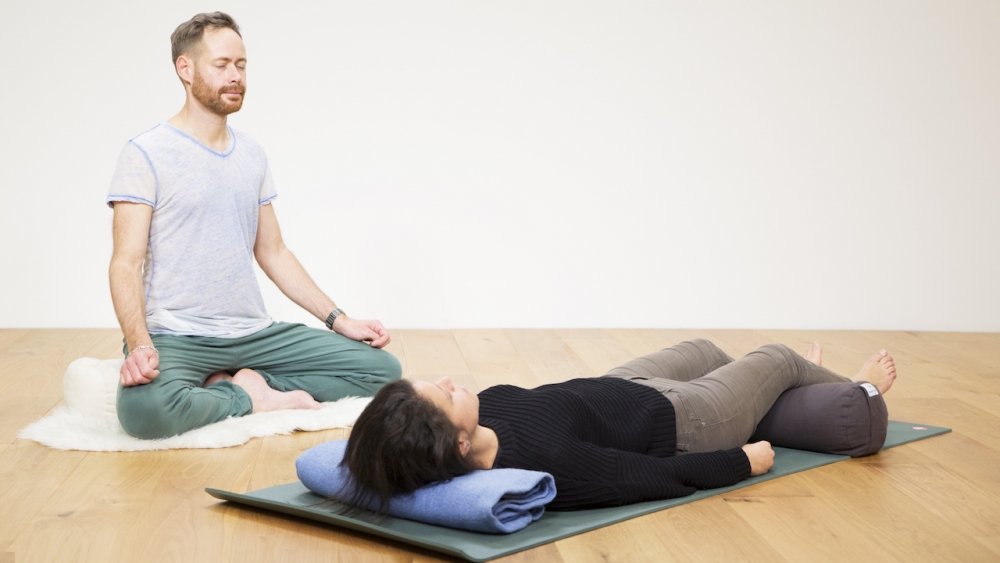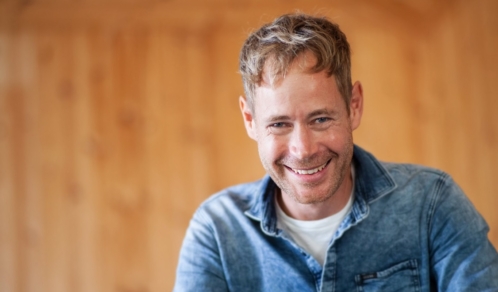What is Yoga Nidra?
Yoga Nidra is a form of guided meditation also known as “yogic sleep” or “effortless relaxation”. It’s usually practiced lying down with a teacher guiding the session. The practice draws our attention inwards, and we learn to surf between the states of wakefulness and sleep, where our body finds its natural state of equilibrium (homeostasis) – the breath balances and becomes quiet, unconscious and conscious aspects of the mind reveal themselves, and we fall into an innate state of deep, blissful awareness.
As we rest here, we can turn our attention easily and effortlessly to the very nature of awareness and consciousness. We start to experience the ‘deeper’ features of yogic teachings that previously we perhaps considered intangible, such as feeling our interconnected wholeness and becoming aware of our true, unified nature – expansive, inclusive, and deeply restful.
Yoga Nidra takes us effortlessly into a state of harmonious, restful being. From here, we can be healed, restored and awakened to our deepest, all-knowing, all-welcoming self. It’s a sublime practice, gaining popularity the world over, and ongoing research continues to prove its effectiveness.
Who is it for?
Absolutely anyone can practice Yoga Nidra, but it has immense appeal for those who struggle to let go (I think many of us have ‘battled’ through meditation at times!). It also has immense value for those suffering from sleep deprivation, trauma, anxiety or depression (to any degree). It’s also perfect for those who have always been curious about the deep states of meditation they have perhaps read about or stumbled across themselves but have never been able to recreate.
The form of Yoga Nidra that I practice and teach is called iRest, and it has a body of research behind it that proves its efficacy at easing the symptoms of the conditions mentioned above, and is proven to be an effective boost to well-being. You can check out some of the research here: www.irest.us/research
In my private clinic I see countless people who are often surprised at the power and efficacy of this practice. Yoga Nidra has become the missing piece for me in my yoga therapy tool bag; paradoxically, because it doesn’t try to fix anything. Instead, through deep heartfelt listening and welcoming, so many problems of the body and mind find harmony and resolution. I delight in teaching this paradox; that what we can truly be with, we ultimately transcend. This is both the heart of yoga and the embodiment of enlightened living – to be with things as they are, and feel this deep surrender to ourselves and toward life.
This is both the heart of yoga and the embodiment of enlightened living – to be with things as they are, and feel this deep surrender to ourselves and toward life.
How do you practice Yoga Nidra?
In short, you lie down and have a rest! The teacher will guide you, usually for around 35 minutes. We start by setting an intention (why are we doing this) and enquiring into our deeper intentions for life (where are we going and are we on track?). Then, specific to iRest, we spend time forming the foundations of an ‘inner resource’ – a playlist of feelings and associations that make you feel safe and well. By connecting with a multi-sensory reflection bought about through memory, imagery and a felt sense, we are given back our birthright of well-being, belonging, security and ease.
Once the foundations of this have been laid, and we have a basic sense of ‘ok-ness’, we can begin to gather concentration and sensory awareness by exploring the body and breath. In effect, you use your senses as a microscope, exploring, listening and welcoming every aspect of the body and breath. This practice leads the body and mind into a deep state of relaxation.
It is now in this state that various hits of emotions, thoughts and beliefs – often unexpected – start to emerge. Perhaps they are experiences or emotions that you’ve not had the chance to deal with, or perhaps you’ve found them too overwhelming and therefore chosen, on whatever level, to repress. With our body and mind rested ‘in neutral’ we are able to welcome and respond to these thoughts, feelings and beliefs in new ways. From this deep, underlying sense of ease we might effectively meet our uncomfortable memory or trauma and through a deep listening and welcoming, come to new understanding or resolution. We may use classical yogic techniques of reflecting on opposites, or feel our underlying true nature of open, spacious awareness, to help us trust and go deeper into our experience.
Once the mind and emotions have been truly seen, heard, welcomed and connected with, they too become increasingly subtle. This gives rise to the final phase of the practice: exploring consciousness. Do you know who you are? Are you aware of your true nature? Do you know what it is to be sentient? Yoga Nidra enables us to dive in and recognize our Self (with a big S) as open, expansive, unbounded, unlimited awareness. This is the ultimate liberation and the highest realization we can come to.
It’s time to dive in and recognize your Self (with a big S) as open, expansive, un-bounded and unlimited awareness. This is the ultimate liberation and the highest realisation we can come to.
Where does Yoga Nidra come from?
Yoga Nidra has its roots in a philosophy called Sankhya that was first written down around 700 BC. Over centuries, people practiced these teachings and expanded upon them – Patanjali and the Buddha being some of its more famous proponents. These teachings were further explored in the philosophy of Advaita Vedanta (meaning ‘not two’ – ‘non-dual’) and a century or so later, the teachings of Kashmir Shaivism.
This encompasses an incredible breadth of experience and practical guidance, all pointing us to a simple truth: at our essence we are the stillness of awareness and that this inner light, when explored, takes us into the macrocosm and the realization of our unity. The practice of Yoga Nidra becomes an experiential map of the history of meditation and encompasses all of these philosophies along its journey.
Why I teach Yoga Nidra
In an ever-increasingly exciting world, with endless information and activities at our fingertips, many of us find it hard to slow down, relax, switch off and rest. Yoga Nidra integrates the facets of resting deeply and at the same time, engaging in a meditative enquiry. For me, the act of lying down to meditate feels so nourishing, so welcoming, so…easy? It might even feel a bit like cheating! Don’t underestimate the power of this practice; through surrender we are born anew into our essential nature of wholeness.
The focus of welcoming and listening brings about a whole new way of being. We feel a deep wellspring of authenticity; we learn to trust ourselves deeply and as we learn to be a good friend to ourselves, we become better at listening to others. Ultimately, in the words of Derek Walcott in his poem, ‘Love After Love’, we begin to ‘fall in love with ourselves again’. This is a practice of healing, kindness and surrender.
I love Yoga Nidra with all my heart. I look forward to practicing Yoga Nidra. I get sad when I don’t have time in my life to practice it. To find something that integrates well-being, restoration and effortless relaxation, and reminds me of my very essence of being, is just too good to pass up. It’s my hope that you will find this love for and affinity with Yoga Nidra too.
Yoga Nidra classes on EkhartYoga
- Join James Reeves in his 8 week course Yoga Nidra: Effortless Awakening.
- You can also follow James’ Playlist of Yoga Nidra extras
Yoga Nidra Teacher Training with James Reeves – EkhartYoga Academy
Get in touch with your true nature and deepest desires, while better understanding the human experience using the tools of Yoga Nidra.
In this comprehensive online course you’ll receive step by step guidance, scripts and audio practices, plus detailed practical techniques to support you in becoming a Yoga Nidra teacher. This course is equally suitable for non-teachers as a personal development course. Learn more on the EkhartYoga Academy.


